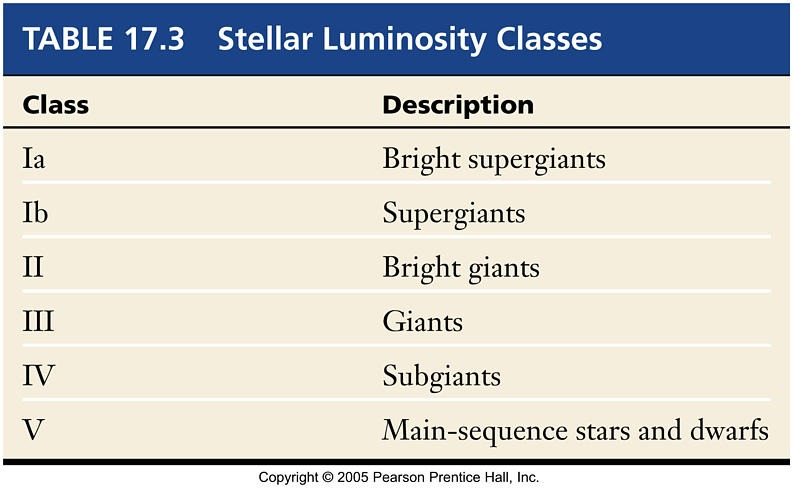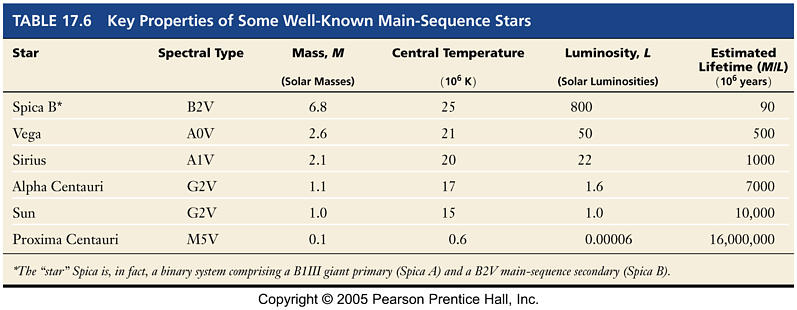Measuring the Stars
Stellar Parallax - method to measure the distance of closest stars
- d (parsecs) = 1/ p (in arc seconds)
- 1 parsec = 3.26 light-years
- a little more than 1 parsec
- Alpha Centauri complex
- Spectroscopic Parallax uses Spectral Class, Brightness, Inverse-square Law, and Main Sequence relationship of Luminosity and Spectral Class
- Motion
- transverse (proper motion) measured directly, after correcting for parallax,
for nearby stars
- radial measured through Doppler effect
- true space motion is the combination of proper motion and radial motion
- radial measured through Doppler effect
- Brightness
- measure of the amount of light reaching the Earth
- also called Apparent Magnitude
- Luminosity
- measure of the total amount of energy or light emitted by star
- also called Absolute Magnitude
- Absolute Magnitude is what the Apparent Magnitude would be if the star were 10 parsecs away
- Brightness (or apparent magnitude) decreases as the inverse-square law
- NOTE
- Luminosity and Absolute Magnitude measure the same property in different units
Brightness and Apparent Magnitude measure the same property in different units
Also will see reference to Apparent Brightness, and Absolute Brightness - also called Absolute Magnitude
- Magnitude Scale
- Defined by Greeks to classify star brightness
- Brightest stars were called Magnitude 1
- Stars barely visible to naked eye called Magnitude 6
- 5 units = 100 x brightness (or luminosity) change
- 1 unit = 2.5 x change
- Brightest star (Sirius) Magnitude -1.5
- The larger the magnitude, the fainter the star
- Magnitude 6 stars - barely visible to the naked eye
- Magnitude 30 - visibility limit of Space Telescope
- Comparison of Luminosity and Absolute Magnitude
- Temperature and Color
- Blackbody theory relates the
color of a star to its surface temperature
- red -> 3,000 K
- orange -> 4,000 K
- yellow -> 6,000 K
- white -> 10,000 K
- blue -> 20,000 K
- Filters
- V (visible)
- B (blue)
- U (ultraviolet)
- Detailed Spectra
- spectral classes (spectral type)
- O B A F G K M
- O is hottest and most massive
- M is coldest and least massive
- O B A F G K M
- Hertzsprung-Russell Diagram
- Absolute Magnitude vs. Spectral Type
- or Luminosity vs. Temperature (reverse order)
- Main Sequence (generates energy through thermonuclear fusion in core)
- Giants (once were main-sequence stars)
- White dwarfs (once were main-sequence stars)
- or Luminosity vs. Temperature (reverse order)
- The cosmic distance scale can be extended with
Spectroscopic Parallax
- Spectroscopic Parallax uses Spectral Class, Brightness, Inverse-square Law, and Main Sequence relationship of Luminosity and Spectral Class
- Luminosity Class
- 90% of the stars are main sequence stars
- We can distiguish the non-main-sequence stars based on the width of spectral lines
- large stars are less dense in the absorbing atmosphere, and therefore have narrower lines

- We can distiguish the non-main-sequence stars based on the width of spectral lines
- Stellar Mass
- Binary stars
- Most stars are in a multiple star system (binary, triple, ...)
- Stars move in elliptic orbits about a common "center of mass"
- Types of binaries
- Stars move in elliptic orbits about a common "center of mass"
- Measuring orbits of binary reveals mass
- Conclusion ->
Luminosity proportional to (Mass)3 for massive main-sequence
stars
and proportional to (Mass)4 for more common main-sequence stars - Consequently -> Lifetime inversely proportional to (Mass)2
for the most massive stars
Or, for massive stars, - approximate
- approximate
- Stellar Lifetime

15 solar mass star has lifetime of only 15 million years, roughly 1/1000 of the lifetime of a star like the Sun
- Stellar Size
- Betelgeuse is large enough, and close enough, to have it's
size
resolved directly
- its radius is about 600 times that of the Sun
- Most stars are too distant, or too small, to measure the size directly
- Combining Luminosity with Temperature gives Stellar Size
- The total luminosity is the area of the star times its surface temperature to the fourth power (Blackbody theory)
- OR -> Luminosity ~ Area x Temp4
- or -> Luminosity ~ Radius2 x Temp4
- and this implies Radius ~ √ Luminosity / Temp2
- this maps out lines on the HR diagram of specific radii of the stars
- Stars above the main sequence are giants
- The red giants are giant stars with surface temperatures making them red (about 3000-4000 K)
- Stars below the main sequence are dwarf
- The white dwarf are very hot, small stars
- Most stars are too distant, or too small, to measure the size directly
- Very important conclusion from "measuring the stars"
- The evolution and properties of a main sequence star is predominantly determined by the mass of the star
- Star clusters
-
Open (or galactic) clusters
- loosely packed, groups of younger stars
- Globular clusters
- tightly packed, groups of the oldest stars known
- older than 10,000,000,000 years
- age determined from "turn-off" point in H-R diagram